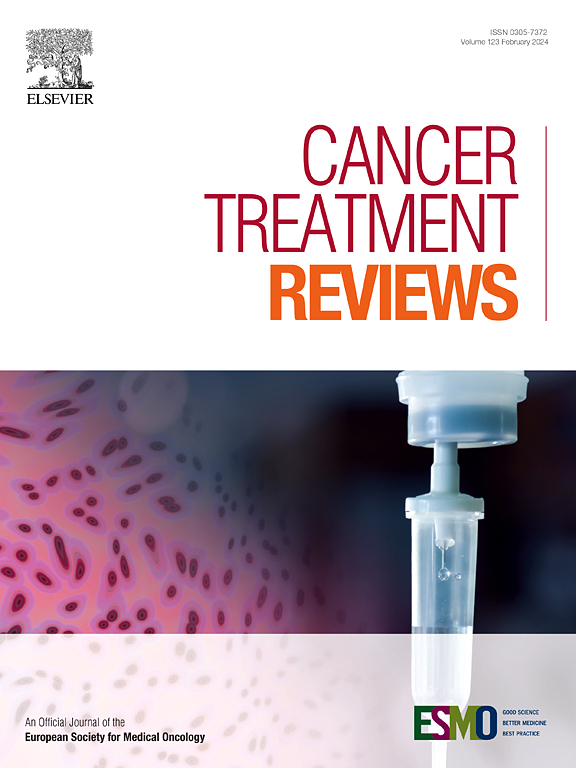Optimal bevacizumab treatment strategy in advanced ovarian cancer: A review
IF 9.6
1区 医学
Q1 ONCOLOGY
引用次数: 0
Abstract
Bevacizumab was the first targeted therapy developed for newly diagnosed and recurrent advanced ovarian cancer (AOC). Although bevacizumab has been approved for the treatment of AOC for several years, identifying patients who may benefit most from this treatment is still debated. Bevacizumab has been associated with improved progression-free survival (PFS) regardless of clinical risk, but in some countries the use of bevacizumab in the treatment of newly diagnosed AOC has been restricted to higher-risk patients (stage III inoperable or suboptimally debulked disease, or stage IV disease); this is primarily due to the findings of exploratory subgroup analyses from phase III trials that suggest only higher-risk patients derive an overall survival (OS) advantage with bevacizumab. Recently reported post hoc analyses from the PAOLA-1 trial of maintenance olaparib plus bevacizumab versus bevacizumab alone for patients with newly diagnosed AOC and homologous recombination deficiency-positive tumors suggested PFS and OS benefit was achieved in both lower-risk (with stage III disease who had undergone upfront surgery and had complete resection) and higher-risk (with stage III disease who had undergone upfront surgery and had residual disease or who had received neoadjuvant chemotherapy, or with stage IV disease) patients, prompting reassessment of the role of bevacizumab in lower-risk patients. This review examines the role of bevacizumab in the AOC treatment pathway by discussing its efficacy and safety in the first-line, maintenance and recurrent settings, and evaluates the clinical implications of bevacizumab use across risk groups and lines of therapy.
晚期卵巢癌的最佳贝伐单抗治疗策略:综述
贝伐单抗是首个针对新诊断和复发的晚期卵巢癌(AOC)开发的靶向治疗药物。尽管贝伐单抗已被批准用于治疗AOC多年,但确定可能从这种治疗中获益最多的患者仍存在争议。无论临床风险如何,贝伐单抗与改善无进展生存期(PFS)相关,但在一些国家,贝伐单抗用于治疗新诊断的AOC仅限于高风险患者(III期不能手术或次优减体积疾病,或IV期疾病);这主要是由于来自III期试验的探索性亚组分析结果表明,只有高风险患者使用贝伐单抗获得总生存(OS)优势。最近报道的PAOLA-1试验的事后分析表明,对于新诊断的AOC和同源重组缺陷阳性肿瘤患者,维持奥拉帕尼加贝伐单抗与贝伐单抗单独治疗的患者,低风险(III期疾病患者接受了前期手术并完全切除)和高风险(III期疾病患者接受了前期手术并有残留疾病或接受了新辅助治疗)均获得了PFS和OS益处化疗,或IV期疾病)患者,促使重新评估贝伐单抗在低风险患者中的作用。本综述探讨了贝伐单抗在AOC治疗途径中的作用,讨论了其在一线、维持和复发环境中的有效性和安全性,并评估了贝伐单抗在危险人群和治疗线中的临床意义。
本文章由计算机程序翻译,如有差异,请以英文原文为准。
求助全文
约1分钟内获得全文
求助全文
来源期刊

Cancer treatment reviews
医学-肿瘤学
CiteScore
21.40
自引率
0.80%
发文量
109
审稿时长
13 days
期刊介绍:
Cancer Treatment Reviews
Journal Overview:
International journal focused on developments in cancer treatment research
Publishes state-of-the-art, authoritative reviews to keep clinicians and researchers informed
Regular Sections in Each Issue:
Comments on Controversy
Tumor Reviews
Anti-tumor Treatments
New Drugs
Complications of Treatment
General and Supportive Care
Laboratory/Clinic Interface
Submission and Editorial System:
Online submission and editorial system for Cancer Treatment Reviews
 求助内容:
求助内容: 应助结果提醒方式:
应助结果提醒方式:


